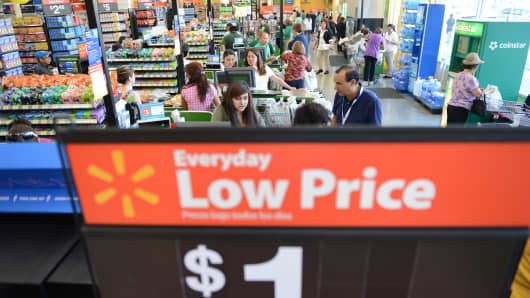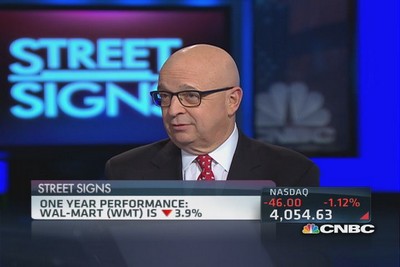Its prices continue to undercut competitors. It's offering a slew of new initiatives, from in-store money-transferring services to organic groceries—even comparison shopping for auto insurance. But despite these strategies—and a broad consumer base driven by low prices—Wal-Mart's U.S. stores are still struggling to gain traction, having posted their fifth-straight quarter of negative same-store sales last week.
At the center of the discounter's domestic woes is its appeal among shoppers who are facing stagnant wage growth and simply can't afford to spend on discretionary items—or in some cases, food."They're lowering prices and they're still not getting the traffic," said Belus Capital Advisors analyst Brian Sozzi.Clearly, Wal-Mart is looking for a new lever to pull in order to boost its sales growth.

Robyn Beck | AFP | Getty Images
Shoppers pay for their purchases at the cash register at a Walmart Neighborhood Market in Panorama City, California.
Although weather played a role in many retailers' earnings for the first quarter, cold temperatures can't be blamed for more than a year of sluggishness in domestic sales, analysts said. Among Wal-Mart's woes is its grocery business—where the company says sales were trimmed by 0.9 percent because of last year's changes to food stamp benefits.With food accounting for more than half of the retailer's business, it's a big blow.
'Stuck in a grey zone'
"The Wal-Mart moms … are shopping on Friday and Saturday after they get paid, and they're not going to the stores on Monday and Tuesday," Sozzi said. Despite the ongoing struggles of its core customer, Sozzi said Wal-Mart is "stuck in this weird gray zone" in terms of appealing to a higher-income consumer. It ran into issues a decade ago when it attempted to shift its apparel category to skew toward higher-end labels, which "flopped" and led to deep markdowns, said Ken Perkins, Retail Metrics president. "They've had so many missteps over the years, particularly in the apparel space," Perkins said. "I've got to believe they're a bit gunshy in that space."
A number of recent initiatives appear aimed at targeting a relatively younger, higher-income consumer, Perkins said. These include its new video-game trade-in program, which launched in March, the organics food push with the Wild Oats label, and a sharper focus on the Web.
Wal-Mart spokeswoman Deisha Barnett said the retailer serves a broad customer range, and its new strategies are aimed at engaging its existing customers and attracting a new customer. "Customers' needs are changing. Period," Barnett said. "This whole idea of wanting to know what is in the foods you're eating, or things to be grown locally or organically, that's not just a trend for a higher-income consumer." In Sozzi's opinion, Wal-Mart needs to continue to go after the low-income consumer, and "hope and pray" that it offers some enticing products in home or organics, which can persuade Macy's or Nordstrom customer to come visit.
Perkins, on the other hand, said he thinks Wal-Mart should also focus on bringing in a higher-income consumer. He added that some of the retailer's recent initiatives, mainly its improving online shopping capabilities, could bring in a new demographic. But he also pointed out that it's incredibly hard to move the needle at a retailer logging billions of dollars in sales.
Wal-mart posts disappointing results
Wal-mart posted weak earnings and is forecasting more weakness ahead.
This is especially true given that a number of midtier consumers who had traded down to Wal-Mart during the recession have now traded back up, Perkins said. "They have to try something," he said of Wal-Mart. "They can't just sit and watch their market share bleed."
Bright spot? Think small
UBS analyst Jason DeRise said he thinks Wal-Mart is taking the right approach in getting its U.S. business back on track—dropping prices across all its categories. And in an April 24 report, Credit Suisse analyst Michael Exstein gave the retailer kudos for beginning to address many of its external issues, including a "deliberate plan" to ramp up its small-store format. Wal-Mart's smaller Neighborhood Markets stores were a bright spot in last week's earnings report, posting a 5 percent same-store sales gain against a "strong and consistent" performance, even in bad weather periods.
Perkins said these stores are less susceptible to weather swings because they are located in more urban areas and can be reached without driving. This will also help to combat high fuel prices that analysts have said contributed to Wal-Mart's woes because the bigger stores tend to be based away from city centers.
Look at Wal-Mart's e-commerce biz
Wal-Mart saw its fifth-straight quarter with stagnant or negative growth for U.S. same-store sales. CNBC contributor Jan Kniffen said Wal-Mart's business mirrors America's economy, and its e-commerce business is outpacing Amazon's.
One danger in the smaller stores, however, is the possible cannibalization effect they could have on Wal-Mart's supercenters, where shoppers would load up on extra discretionary items, Perkins said. Sozzi said the discounter needs to take its store footprint plans even one step further and shrink its supercenters. In the company's earnings call, Wal-Mart U.S. President Bill Simon said 10 percent of its domestic stores are underperforming. Despite significant external headwinds, Perkins said there is still room for Wal-Mart to send its U.S. segment back into positive territory—so long as the economy cooperates. "There is a chance for this to turn around," he said. "They key hinges on that lower-income consumer finally getting some relief."


No comments:
Post a Comment